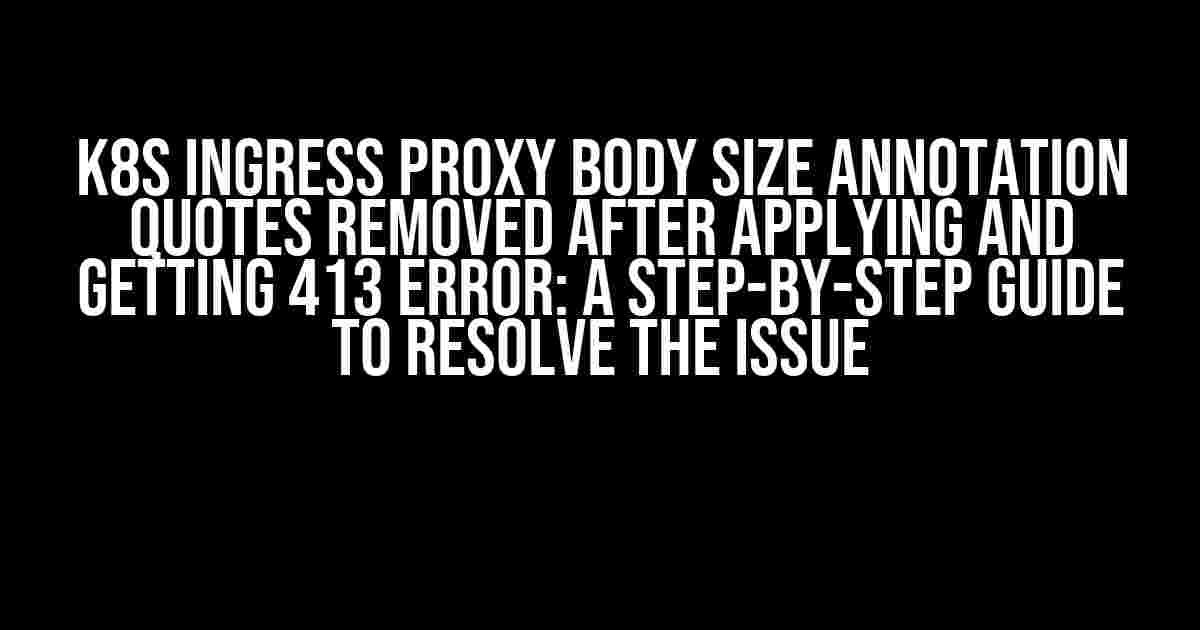Are you tired of dealing with the frustrating 413 error when trying to access your Kubernetes application through an ingress proxy? Do you find yourself scratching your head, wondering why the quotes around your body size annotation magically disappear after applying the changes? Fear not, dear reader, for today we’ll embark on a thrilling adventure to resolve this issue once and for all!
The Problem: Quotes Removed, 413 Error Ensues
Let’s set the scene: you’ve carefully crafted your ingress resource, specifying the `nginx.ingress.kubernetes.io/proxy-body-size` annotation to ensure your application can handle larger requests. You’ve added the quotes around the value, making sure it’s properly formatted. You apply the changes, and… voilà! The quotes disappear, leaving you with a cryptic 413 error.
apiVersion: networking.k8s.io/v1
kind: Ingress
metadata:
name: example-ingress
annotations:
nginx.ingress.kubernetes.io/proxy-body-size: "500m"
What sorcery is this?! Why did the quotes vanish, and how do we get them back?
Understanding the Root Cause: The Annotation Parsing Quirk
The answer lies in how Kubernetes parses annotations. When you apply an annotation with quotes, Kubernetes treats the entire string as a single value, sans quotes. This means that the quotes are effectively removed, leaving your poor ingress resource with an invalid configuration.
To illustrate this, let’s examine the annotation parsing process:
- Original annotation: `nginx.ingress.kubernetes.io/proxy-body-size: “500m”`
- Kubernetes parsing: `nginx.ingress.kubernetes.io/proxy-body-size: 500m` (quotes removed)
- Ingress resource: receives an invalid configuration, leading to the 413 error
Resolving the Issue: The Quote Conundrum Solved
Now that we’ve identified the root cause, it’s time to find a solution. The trick lies in using a clever combination of quotes and escapes to ensure the annotation is parsed correctly.
Here’s the corrected annotation:
apiVersion: networking.k8s.io/v1
kind: Ingress
metadata:
name: example-ingress
annotations:
nginx.ingress.kubernetes.io/proxy-body-size: "\"500m\""
Notice the escapes (`\`) around the quotes? These tell Kubernetes to preserve the quotes, allowing the annotation to be parsed correctly.
Apply the corrected annotation, and voilà! Your ingress resource should now be properly configured, and the 413 error should disappear.
Additional Tips and Best Practices
To avoid similar issues in the future, keep the following tips in mind:
- Always use escapes around quotes in annotations to ensure they’re preserved.
- Verify your annotation formatting using tools like `kubectl get ingress -o yaml`.
- Regularly review your ingress resource configurations to catch potential issues.
Conclusion: Mastering the Art of Annotations
In conclusion, the mysterious case of the disappearing quotes has been solved! By understanding the annotation parsing quirk and applying the corrected solution, you’ll be well on your way to creating robust and efficient ingress resources for your Kubernetes applications.
Remember, in the world of Kubernetes, attention to detail is crucial. With this newfound knowledge, you’ll be better equipped to tackle even the most obscure issues and ensure your applications shine like a beacon of hope in the cloud-native landscape.
| Issue | Solution |
|---|---|
| Quotes removed from annotation | Use escapes around quotes (`\”`) to preserve them |
| 413 error when accessing application | Correctly formatted annotation with preserved quotes |
Now, go forth and annotate like a pro!
This article is a comprehensive guide to resolving the issue of quotes being removed from annotations in Kubernetes ingress resources, leading to 413 errors. We’ve covered the root cause of the problem, the solution, and provided additional tips and best practices for mastering annotations in Kubernetes.
Frequently Asked Question
Kubernetes Ingress Proxy Body Size Annotation can be a bit tricky, but don’t worry, we’ve got you covered! Here are some answers to your burning questions.
Why are quotes removed from my Kubernetes Ingress Proxy Body Size Annotation after applying?
This is a known issue in Kubernetes. The quotes are removed because the annotation value is treated as a string. To avoid this, you can use a JSON encoded string instead. For example, `proxy-body-size: ‘{“limit”: “10m”}’`. This will ensure the quotes are preserved and the annotation is applied correctly.
What is the default proxy-body-size limit in Kubernetes Ingress?
The default proxy-body-size limit in Kubernetes Ingress is 1MB (1048576 bytes). If you need to increase this limit, you can do so by adding the `proxy-body-size` annotation to your Ingress resource.
Why am I getting a 413 error after applying the proxy-body-size annotation?
You’re getting a 413 error because the request body exceeds the proxy-body-size limit. Check your Ingress logs to determine the actual request body size and adjust the `proxy-body-size` annotation accordingly. Remember to restart your Ingress controller after updating the annotation.
Can I set the proxy-body-size annotation at the IngressClass level?
Yes, you can set the `proxy-body-size` annotation at the IngressClass level. This will apply the annotation to all Ingress resources that use that IngressClass. Simply add the annotation to your IngressClass definition, and it will be inherited by all associated Ingress resources.
How do I verify that the proxy-body-size annotation is applied correctly?
To verify that the `proxy-body-size` annotation is applied correctly, check the Ingress resource definition using `kubectl get ingress

